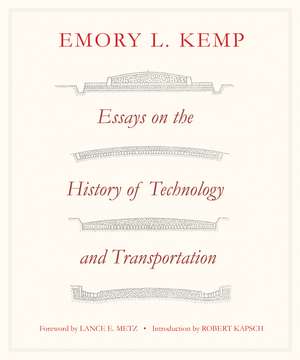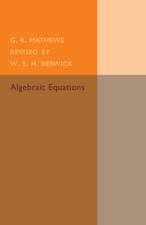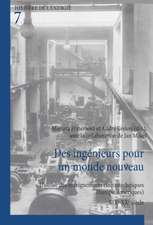Essays on the History of Transportation and Technology
Autor EMORY L. KEMP Cuvânt înainte de Lance E. Metz Introducere de Robert J. Kapschen Limba Engleză Hardback – oct 2014
Emory Kemp is the founder and director of the Institute for the History of Technology and Industrial Archaeology at West Virginia University, where he also served as a chair and professor of civil engineering and a professor of history. This collection of essays encompasses over fifty years of his research in the field of the history of technology.
Within these twelve essays, Kemp describes and analyzes nineteenth century improvements in building materials such as iron, steel, and cement; roads and bridges, especially the evolution of the suspension bridge; canals and navigable rivers, including the Ohio River and its tributaries; and water supply systems. As one of the few practicing American engineers who also researches and writes as an academic, Kemp adds an important historical context to his work by focusing not only on the construction of a structure but also on the analytical science that heralds a structure’s design and development.
Within these twelve essays, Kemp describes and analyzes nineteenth century improvements in building materials such as iron, steel, and cement; roads and bridges, especially the evolution of the suspension bridge; canals and navigable rivers, including the Ohio River and its tributaries; and water supply systems. As one of the few practicing American engineers who also researches and writes as an academic, Kemp adds an important historical context to his work by focusing not only on the construction of a structure but also on the analytical science that heralds a structure’s design and development.
Preț: 321.27 lei
Nou
Puncte Express: 482
Preț estimativ în valută:
61.48€ • 63.95$ • 50.76£
61.48€ • 63.95$ • 50.76£
Carte disponibilă
Livrare economică 25 martie-08 aprilie
Preluare comenzi: 021 569.72.76
Specificații
ISBN-13: 9781938228810
ISBN-10: 1938228812
Pagini: 432
Ilustrații: 49
Dimensiuni: 191 x 229 x 33 mm
Greutate: 0.95 kg
Ediția:1st Edition
Editura: West Virginia University Press
Colecția West Virginia University Press
ISBN-10: 1938228812
Pagini: 432
Ilustrații: 49
Dimensiuni: 191 x 229 x 33 mm
Greutate: 0.95 kg
Ediția:1st Edition
Editura: West Virginia University Press
Colecția West Virginia University Press
Notă biografică
Emory Kemp has been a practicing engineer for more than half a century, as both a chartered civil engineer and structural engineer in Great Britain, and elected a distinguished engineer in the American Society of Civil Engineers. He is the founder and director of the Institute for the History of Technology and Industrial Archaeology at West Virginia University, where he was also chair and professor of civil engineering in the College of Engineering, and a professor of history in the Eberly College of Arts and Sciences. He has served as president of the Public Works Historical Society, is a codirector of the Smithsonian Institution/West Virginia University Joint Project for the History of Technology, and has presented numerous papers and published many articles on industrial archeology, engineering, the history of technology, structural mechanics, and public works in journals such as the Journal of the Society for Industrial Archaeology, Public Historian, Essays in Public Works History, Public Works Magazine, and Canal History and Technology Proceedings. He lives in Morgantown, WV.
Cuprins
Foreword, Lance E. Metz
Preface
Introduction, Robert Kapsch
1. The 1959 Wheeling Custom House: A Harbinger of Iron and Steel Skeletal Framing
2. Charles Ellet Jr. (1810-1862): Portrait of an Engineer
3. A Thoroughfare Through the Howling Wilderness: The Weston & Gauley Bridge Turnpike, Emory L. Kemp and Janet K. Kemp
4. The Pulaksi Skyway—Railway Economic Theory Applied to Superhighway Design, Dara Callender and Emory Kemp
5. James Finley and the Origins of the Modern Suspension Bridge
6. French Movable Dams in America
7. Building the Tennessee-Tombigbee Waterway
8. Bejamin Franklin Thomas and the Introduction of the French Needle Dam into the United States
9. John Jervis and the Hydraulic Design of the Old Croton Aqueduct, Emory Kemp and Edward Winant
10. The Muskingum Navigation
11. French Movable Dams on the Great Kanawha River
12. The Little Kanawha Navigation, Larry Sypolt and Emory Kemp
Acknowledgments
About the Authors
Preface
Introduction, Robert Kapsch
1. The 1959 Wheeling Custom House: A Harbinger of Iron and Steel Skeletal Framing
2. Charles Ellet Jr. (1810-1862): Portrait of an Engineer
3. A Thoroughfare Through the Howling Wilderness: The Weston & Gauley Bridge Turnpike, Emory L. Kemp and Janet K. Kemp
4. The Pulaksi Skyway—Railway Economic Theory Applied to Superhighway Design, Dara Callender and Emory Kemp
5. James Finley and the Origins of the Modern Suspension Bridge
6. French Movable Dams in America
7. Building the Tennessee-Tombigbee Waterway
8. Bejamin Franklin Thomas and the Introduction of the French Needle Dam into the United States
9. John Jervis and the Hydraulic Design of the Old Croton Aqueduct, Emory Kemp and Edward Winant
10. The Muskingum Navigation
11. French Movable Dams on the Great Kanawha River
12. The Little Kanawha Navigation, Larry Sypolt and Emory Kemp
Acknowledgments
About the Authors
Textul de pe ultima copertă
Emory Kemp is the founder and director of the Institute for the History of Technology and Industrial Archaeology at West Virginia University, where he also served as a chair and professor of civil engineering and a professor of history. This collection of essays encompasses over fifty years of his research in the field of the history of technology.
Within these twelve essays, Kemp describes and analyzes nineteenth century improvements in building materials such as iron, steel, and cement; roads and bridges, especially the evolution of the suspension bridge; canals and navigable rivers, including the Ohio River and its tributaries; and water supply systems. As one of the few practicing American engineers who also researches and writes as an academic, Kemp adds an important historical context to his work by focusing not only on the construction of a structure but also on the analytical science that heralds a structure’s design and development.
Within these twelve essays, Kemp describes and analyzes nineteenth century improvements in building materials such as iron, steel, and cement; roads and bridges, especially the evolution of the suspension bridge; canals and navigable rivers, including the Ohio River and its tributaries; and water supply systems. As one of the few practicing American engineers who also researches and writes as an academic, Kemp adds an important historical context to his work by focusing not only on the construction of a structure but also on the analytical science that heralds a structure’s design and development.
















